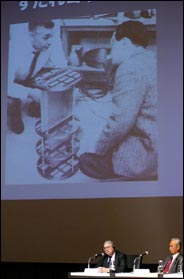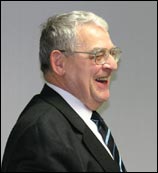 |
 |
The Nobel Prize in Physics was awarded to Dr. Giacconi for his achievement as a founding father of X-ray astronomy. At the dawn of the field, Dr. Giacconi collaborated closely with Dr. Minoru Oda, the former Director General of ISAS. The photo is the two of them looking at the modulation collimator (or a "bamboo screen collimator" in Japanese), which accurately determines the direction of an X-ray source. It originated from Dr. Oda's idea, and is an observation device that symbolizes Japan's contribution to X-ray astronomy. |
|
The atmosphere of the Earth is so thick that X-rays from space cannot reach the ground. Therefore, we had to wait for the development of a rocket that could transport observation equipment to the outer atmosphere.
X-ray research had been done for many years before 1962. In particular, the experiments done by the Naval Research Laboratory group, lead by [Herbert] Friedman, were showing significant results. Using the V2 rocket the United States gained from Germany after the war, they were studying the Sun, which is the closest fixed star from the Earth, and X-rays emitted from there. Then they studied solar coronas and found that along with extremely high heat, they also release X-rays. They continued their research, but though the performance of their detectors was good enough for the Sun, it wasn't enough to catch the subtle X-ray emissions from other celestial bodies.
There are other fixed stars as bright as the Sun that emit X-rays, but even the next-closest fixed stars to the Earth are at such great distances that by the time their X-rays reach the Earth, they are down to about one-millionth of their original strength. For this reason I tried to make devices that could detect X-rays from dark celestial bodies at such great distances.
I had two projects going at the same time for this purpose, since I wasn't sure which of them would work.



Before his lecture, Dr. Giacconi at a buffet party held at the National Museum of Emerging Science and Innovation. |
|
 |
 |
For the first project, we used a similar detector to the one Friedman was using, but added a new function to remove background particles. We tried to create a system that had much higher performance than had ever existed before. Broadening the view to prevent missing X-rays from any celestial bodies, we tried to make the largest detector ever. As a result, though the first flight exploded and failed, we achieved performance that was 100 times greater than had ever been achieved with the second and third experiments.
However, our success in discovering X-rays from Scorpius X-1 was thanks to its unexpected brightness. It was a new type of a star that nobody had ever imagined, and a new mechanism for X-ray emission.
The second project was to develop a telescope to detect X-rays. We were assuming back then that X-ray stars were so dark that we would need a more advanced detector than condensers. Many years were spent on this project, so we were fortunate to succeed in the first project.
|



